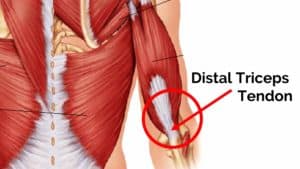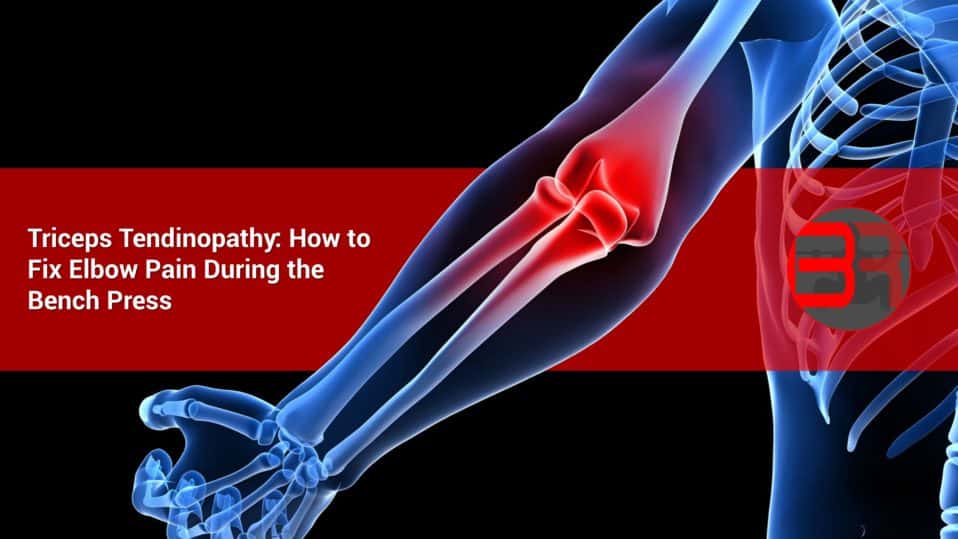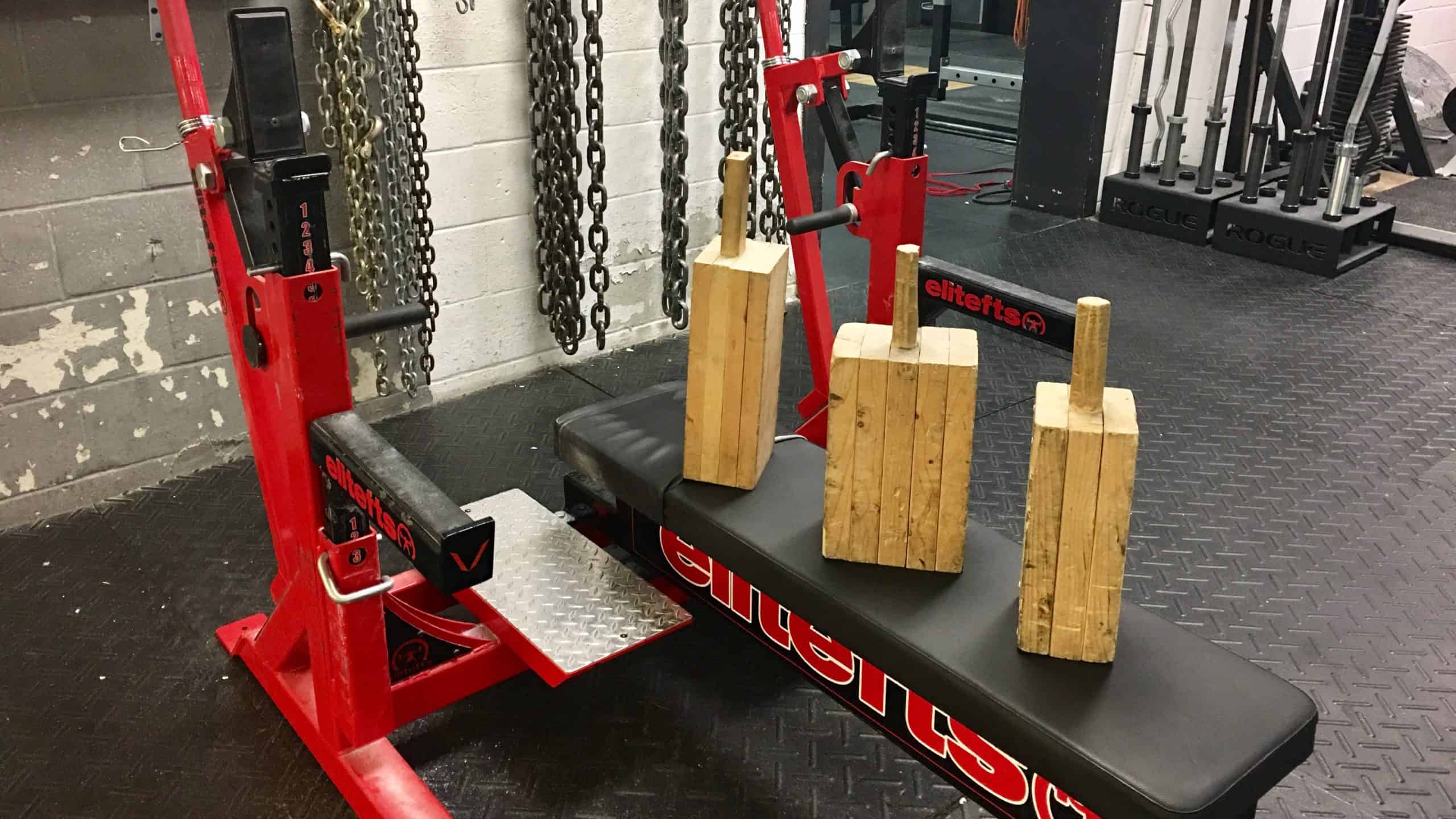Dealing with elbow pain during the bench press can be an annoying injury. Fortunately, with optimal management, you can overcome it. Here’s exactly how to do that.
What Does “Tendinopathy” Mean Anyways?
Tendinopathy is the broad term used in the medical profession to describe painful conditions occurring in and around tendons. We used to categorize tendon pain as either “tendinitis” if it was more in the acute stages and “tendinosis” if it was in more of a degenerative state, but this is no longer the case.
Evidence suggests that there may not even be an inflammatory component to tendinopathies, hence the recommendation to avoid the term “tendinitis” (which implies a case of inflammation).
Instead, we now categorize tendinopathy on a continuum as being either reactive, in dysrepair, or degenerative. Management for each of these cases will be different as well.
What Causes Tendinopathy?
Tendinopathy usually occurs when you overload a tendon too quickly. It’s not that you did something “wrong,” rather you may have just done too much, too fast, too soon. As a result, you experience pain and discomfort in the tendon.
The key to overcoming it is modifying the way you perform the activity to temporarily offload it, and then gradually exposing it to the load again in order to force an adaptation. As you will see, this is exactly how you’ll overcome your elbow pain during bench press.
What is Triceps Tendinopathy?
Triceps tendinopathy is characterized by pain and discomfort in the back of your elbow. It is usually localized to where your triceps tendon attaches to the olecranon process of your elbow.

While pain can also occur on the inside of the elbow (medial epicondylalgia a.k.a “golfer’s elbow), or on the outside of the elbow (lateral epicondylalgia a.k.a “tennis elbow”), we will be focusing purely on triceps tendinopathy in this article.
If you’re dealing with elbow pain during the bench press, there’s a good chance you’re dealing with a triceps tendinopathy. The first step to overcoming this is modifying your lift to remove the aggravating factor.
What’s Aggravating Your Elbow?
There are a few common aggravating factors that could be causing your elbow pain during the bench press. Sometimes, it’s only painful at a specific part of the lift. Other times it may be aggravated at only higher intensities.
Are you only experiencing posterior elbow pain at a certain RPE or percent of one-rep max? Maybe it’s only happening on the last few reps of your last set. If that’s the case, then decreasing the load and slowing the movement down may be your best bet.
Decrease the Load and Slow the Movement Down
Cranky tendons love tempo. If you’re experiencing elbow pain during the bench press, work on slowing the movement down. For the tempo bench press, I’d recommend a 3:0:3 speed. This consists of a 3 second eccentric (lowering phase), no pause at the bottom, and a 3 second concentric (lifting phase).
Since you’re slowing the movement down, you won’t need to go as heavy to achieve a sufficient mechanical stimulus either. Decreasing the load and performing a tempo bench press may be all you need to do in order to overcome your elbow pain.
Widen Your Bench Press Grip
Another modification you can make to help reduce your elbow pain during the bench press is to widen your grip. For a given weight, narrower grips will place more stress on the triceps.
As you widen the grip, it will generally shift the stress off of the triceps and more onto the pectorals. This may be exactly what you want to do initially if you have elbow pain with the bench press.
Widening the grip can help temporarily offload your triceps and make it more tolerable for your elbow overall.
Limit the Painful Part of the ROM
Pain at the bottom of the lift. If you’re only having elbow pain at the bottom of the bench press, you can try and perform a variation like the floor press or pin press to temporarily limit it. By limiting the aggravating portion of the lift, you can continue to elicit a tolerable training effect.
Pain at lockout. Sometimes, triceps tendinopathy only hurts at the lockout of the lift. In this case, you can temporarily perform a “soft lockout” during the bench press or overhead press. In other words, instead of aggressively locking your elbow into extension at the top, stop the movement just before the lockout.
The entire goal of the beginning phase of overcoming your triceps tendon pain is limiting the aggravating factor. As you can see, by manipulation of form, load, and ROM, you have a lot of options.
Dosing in Isometrics for Pain Control
Another useful tactic for managing tendinopathy is dosing in isometrics. Isometrics have been shown to produce an analgesic pain-reducing effect. This would be especially useful if you’re someone dealing with elbow pain right at lockout.
After a period of time of modification and avoidance (limiting the lockout position), you can add in exercises like shoulder taps or an alternating dumbbell bench press so that you spend MORE time in the lockout position to force the adaptation.
While the shoulder tap exercise is traditional used for shoulder stability, it can also be beneficial for treating a triceps tendinopathy due to the increased isometric demands of the triceps.
The alternating dumbbell bench press forces you to maintain an isometric triceps contraction on the non-working arm while the other arm is doing the movement! However, you can’t modify and avoid forever…
Sometimes With Tendons…You Just Need to Load it!
While eliminating and modifying the aggravating factors for your elbow pain is certainly an important step to mitigating symptoms, it’s not the only step. Once symptoms calm down, it’s important to directly load the tendon again to build up its strength and capacity!
One way to build tendon strength is to directly load it with an isolation exercise. If you’re dealing with a triceps tendinopathy or elbow pain with the bench press, dosing in a pushdown movement works really well here. Unilateral underhand cable extensions or banded pushdowns are two great options.
Ideally, you would perform both of these with a much slower tempo than the video shows. Remember the 3:0:3 guideline – 3 seconds on the way down and 3 seconds on the way up.
I would dose these in 3x/week at the end of your workout for 3 sets of 10-15 reps. Make sure you take 24-48 hours rest in between sessions as well to allow for optimal recovery.
Does This Process Need to Be Pain-Free?
When dealing with any tendinopathy, the process itself does NOT need to be pain-free, but it should be tolerable. For the exercise modifications and isolation work, generally you can work into a 3-4/10 pain as long as it’s not worse 24 hours after your workout.
If you experience a flare-up 24 hours after, your symptoms would be considered “irritable” and you may need to go back to the drawing board and manipulate the ROM or dosage again.
If, instead, you work into a 3-4/10 pain, but your symptoms are back to baseline, this would be considered a stable response, and you continue to proceed as planned. I explain the process of training with pain in more detail in this Whiteboard Wednesday YouTube Video.
What About Soft Tissue Work? Should I Be Massaging or Stretching My Triceps?
Massaging and stretching may help temporarily change your pain, but they aren’t going to permanently fix anything. So while I don’t personally prescribe these, if you get temporarily relief from it and it makes you feel good, who am I to tell you to stop? This is a topic we touch on in the Barbell Rehab Workshop.

Just be careful though. It is easy to go down the rabbit hole with these interventions. In other words, while five minutes of self-myofascial release (SMR) may help initially, you may eventually need 30 minutes down the road to get the same desired effect.
Your body can adapt very quickly to these interventions. So while they may help you feel better in the short-term, they aren’t long term solutions and they aren't necessary for a successful outcome.
A Note on Direct Pressure on Tendons
Aggravating factors may also occur outside of the gym setting. In general, tendinopathies are aggravated by too much direct pressure.
For a triceps tendinopathy, this includes sitting for prolonged periods of time with your elbow resting on a hard desk or the center console in your car while driving.
If you’re having elbow pain and having a difficult time getting it to calm down, I’d try and limit direct pressure on it outside the gym as well.
Tying it All Together
As with any tendinopathy, the main goal is to temporarily modify or avoid the aggravating factor, and then slowly build your tolerance back up to it. If you’re dealing with elbow pain during the bench press here’s what I’d do:
- First, try widening your grip, decreasing the load, and performing a tempo bench press. This will help offload the triceps a bit but will still continue to elicit a training effect.
- If you’re having pain at just one part of the ROM, temporarily remove that part and train a suitable variation (either a floor press or a bench press with a soft lockout).
- Dose in exercises like the alternating dumbbell bench presses or shoulder taps to provide an isometric stimulus to the triceps tendon. This can help reduce pain.
- Once the pain is tolerable, add an isolation exercise like the underhand triceps extension or banded triceps pushdown in order to force an adaptation and build tendon capacity.
If you’re someone dealing with elbow pain during the bench press, the tips above will help you overcome it.
If you’re more of a auditory learner, check out the video below. This is part of our Whiteboard Wednesday YouTube Series, where every week, we talk about a different subject related to pain and performance!





